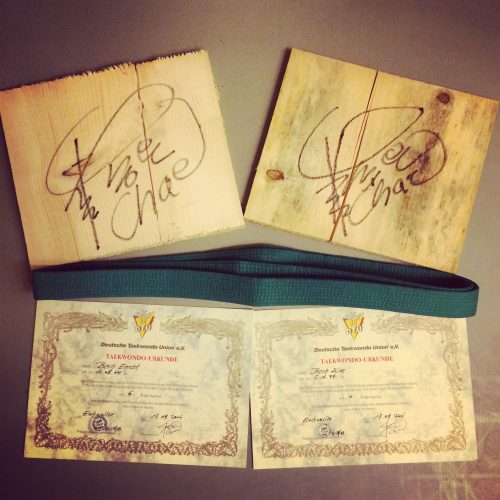If there is one thing that I love about Martial Arts (if I had to choose) it would be that the learning never stops.
It’s not supposed to.
This might sound cliché, but most probably that’s simply because it’s true.
What makes it even better is that the learnings seem to transfer to other (life!) skills and art forms as well.
By continually working at (and slightly beyond!) the edges of our current skill level, we also train our very capacity to learn.
Another principle I deeply appreciate is the belt ranking system as it is applied in Taekwondo/Haidong Gumdo.
The colour grades tell you about the minimim level of skill that is expected, yet each student still has their own unique ‘style’ and preferences.
Whichever level one is at, an upcoming grade test will spur on a Martial Arts student to work on deepening their strengths as well as to bravely address their ‘weaknesses’.
The test day itself teaches to plan and prepare focusedly for specific events, but also to stay cool and recall/apply what has been trained for – even under mental (and physical) duress.
But most importantly… after you pass a test.. you may celebrate, receive a new belt, and you will eventually go home, recover, reflect and rest a bit.. But as soon as you return to the dojang for the following training.. you immediately get to work, and your practise is now geared towards the next level. There is no ‘end’.
For a black belt (Dan) it is much the same.
Training is not ‘complete’ once you earn a your first Dan grade – it simply means you are now ready to ‘go deep’ with training.
For each following grade the number of years/hours of required training grows, which essentially means you can train, learn and progress your entire life and still have a next level of Mastery to work towards to.

I sometimes feel this idea could be very useful in dance (perhaps not literally – unless we could be testing for/awarding coloured hip belts/leotards?) – it would not say anything about the artistry, or the soul of a dancer, of course, and as some dance forms have a strong social aspect to it it’s not always evident to draw a practically applicable parallel to the ways of mastering Martial Arts.
However.
What I do like about the belt ranking system is that it makes it ‘normal’ to be practising and growing (with the inevitable plateaus in between) continually – at the level one is able to, of course.
Progress, even if small, is simply expected to occur as a result of focused training, practise, persistence, guidance, and patience.
This is a principle we can apply to anything in life, it transcends the Martialness of Arts.
For a great book on this, check out George Leonard’s The Path to Mastery.
